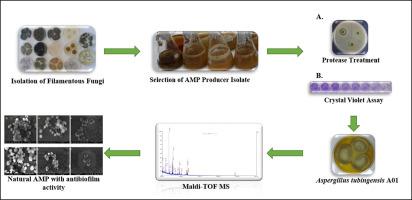Journal of Proteomics ( IF 2.8 ) Pub Date : 2020-12-09 , DOI: 10.1016/j.jprot.2020.104075 Ayşenur Yazici 1 , Serkan Örtücü 1 , Mesut Taşkin 2

|
In the present study, 120 fungal isolates were locally isolated from soil and selected according to their ability to antimicrobial activity. Then, selected isolates were tested for their ability to prevent biofilm formation and only one isolate (A01) showed an antibiofilm effect. The isolate A01 identified as Aspergillus tubingensis by sequencing of the 18S ITS region and a segment of β-tubulin gene. Then, 5 fractions were prepared from the culture filtrate of A. tubingensis A01 using the ultrafiltration technique to find active polypeptide fraction. The experiments revealed that one of them had an antibiofilm activity. The MALDI-TOF/MS analyses demonstrated that this polypeptide composed of 92 amino acids and had a molecular mass of 10,087 Da. The sequence alignment showed homology with hypothetical protein (OJI81679.1). The gene coding for this polypeptide consisting of 279 nucleotides, herein we called astucin, was cloned and sequenced from A. tubingensis A01 to confirm results. The MIC of the purified polypeptide was 32 m/L and 128 μg/mL and the MBIC was 2 and 8 μg/mL against Staphylococcus aureus and MRSA, respectively. The results demonstrated that the antimicrobial and antibiofilm activity of astucin, together with its lack of cytotoxicity, makes it an alternative for application in medicine.
Significance
Antibiotic resistance is a global problem and the emergence of antibiotic resistant bacteria reduce the effect the current treatment approaches. In this context, antimicrobial peptides stand out as potentional agents to combat bacterial infection especially, biofilm related infections. Importantly, this study have greatly considered our understanding for fungal derived antibiofilm polypeptides. In this study, traditional selection method combined with crystal violet assay is used to investigate antibiofilm polypeptides. We identified antibiofilm polypeptides purified from A. tubingensis A01. This protein shows antimicrobial and antibiofilm activity against S. aureus.
中文翻译:

新型丝状真菌抗生物膜多肽的筛选与鉴定
在本研究中,从土壤中局部分离出120种真菌分离株,并根据其抗微生物活性的能力进行选择。然后,测试了选定的分离株防止生物膜形成的能力,只有一种分离株(A01)表现出抗生物膜作用。通过对18S ITS区域和β-微管蛋白基因的一段片段进行测序,将分离物A01鉴定为管曲霉。然后,从油曲霉的培养滤液中制备5个级分A01采用超滤技术寻找活性多肽组分。实验表明,其中之一具有抗生物膜活性。MALDI-TOF / MS分析表明该多肽由92个氨基酸组成,分子量为10087 Da。序列比对显示与假定蛋白(OJI81679.1)的同源性。编码此多肽的基因由279个核苷酸组成,在本文中称为astucin,是从油曲霉A01克隆并测序的,以确认结果。纯化的多肽对金黄色葡萄球菌的MIC为32 m / L和128μg/ mL,MBIC为2和8μg/ mL。和MRSA分别。结果表明,阿斯杜星的抗微生物和生物膜活性以及缺乏细胞毒性,使其成为药物中的替代品。
意义
抗生素抗性是一个全球性问题,抗生素抗性细菌的出现降低了当前治疗方法的效果。在这种情况下,抗菌肽作为对抗细菌感染,尤其是与生物膜相关的感染的有力制剂而脱颖而出。重要的是,这项研究极大地考虑了我们对真菌衍生的抗生物膜多肽的理解。在这项研究中,传统的选择方法结合结晶紫分析法被用来研究抗生物膜多肽。我们鉴定了从油曲霉A01纯化的抗生物膜多肽。该蛋白对金黄色葡萄球菌具有抗微生物和生物膜活性。









































 京公网安备 11010802027423号
京公网安备 11010802027423号